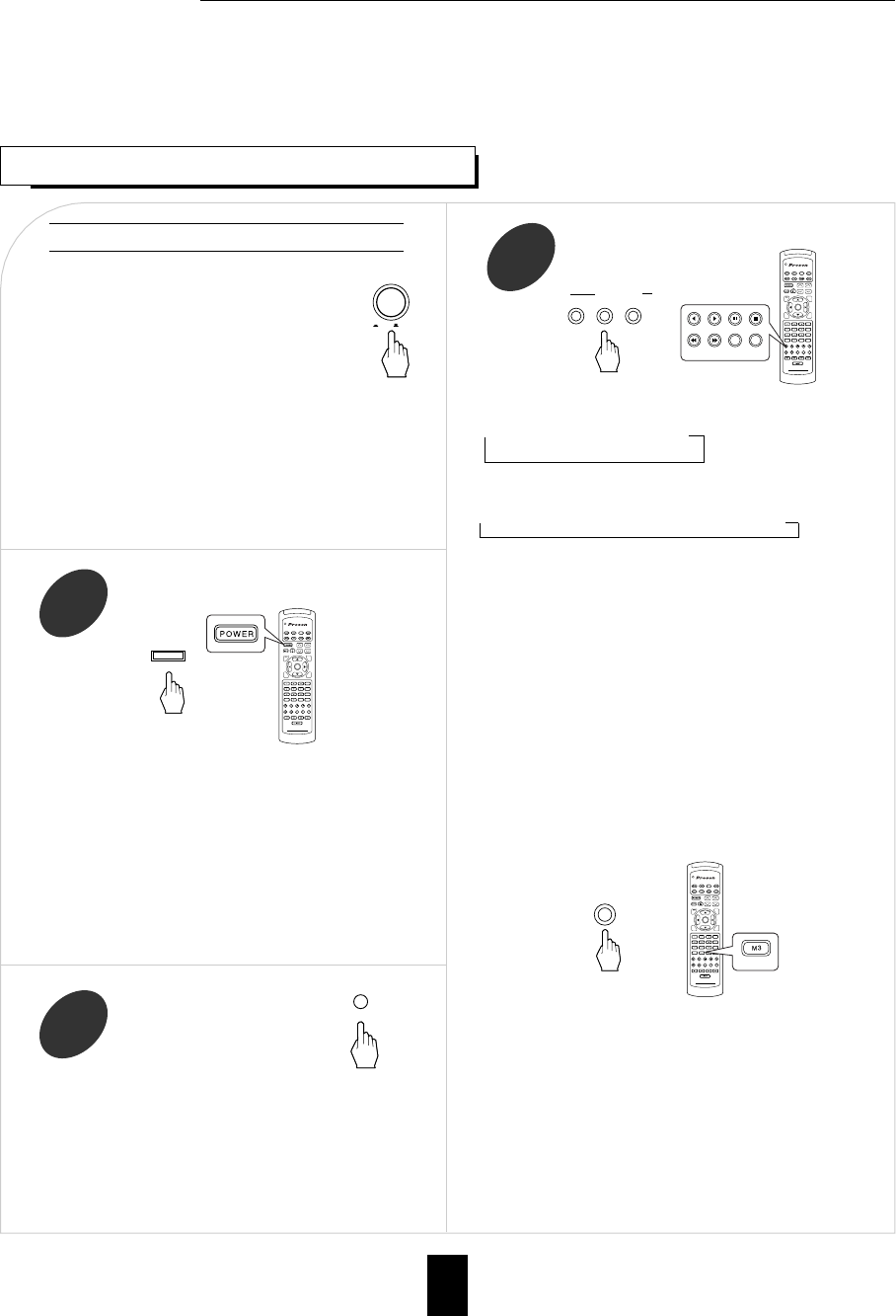
15
LISTENING TO A PROGRAM SOURCE
Operations
Before operation
Select the desired input source.
3
• Enter the standby mode.
• The STANDBY button lights up in red.
This means that the receiver is not
disconnected from the AC mains and a
small amount of current is retained to
support the memorized contents and
operation readiness.
• To switch the power off, push the POWER switch
again.
• Then power is cut off and the STANDBY button
goes off.
• Each time the STANDBY button on the front panel or
the POWER button on the remote control is pressed,
the receiver is turned on to enter the operating
mode(the STANDBY button lights up in blue) or off
to enter the standby mode (the STANDBY button
lights up in red).
• In the standby mode, if one of the INPUT
SELECTOR buttons is pressed, the receiver is turned
on automatically and the desired input is selected.
• Then the SPEAKER indicator lights up on the display
and the sound can be heard from the speakers
connected to the speaker terminals.
• When using the headphones for private listening,
press the SPEAKER button again to switch the
speakers off.
• Each time the “AUDIO” button is pressed, the input source
changes as follows:
TUNER CD AUX
(frequency display)
• Each time the “VIDEO” button is pressed, the input source
changes as follows:
VIDEO 1 VIDEO 2 VIDEO 3 VIDEO 4
• When the TAPE MONITOR button is set to on so that
“TAPE MON” lights up, other inputs can not be heard from
the speakers.
To listen to an input source except TAPE MONITOR, be
sure to set the TAPE MONITOR button to off.
TAPE MONITOR function
You can connect either a tape deck or a graphic equalizer to the
receiver’s TAPE MONITOR jacks.
Only when you listen to the component connected to these jacks,
set the TAPE MONITOR button to on.
If you connect a 3-head tape deck, you can listen to the sound
being recorded during recording, not the source sound.
For further details, refer to the operating instructions of the
component connected.
When selecting the 7.1 CH DIRECT as desired
• According to the surround back speaker setting. “7.1(,6.1 or
5.1) CH DIRECT” is displayed and the 8(/7/6) separate
analog signals from 7.1 CH decoder connected to this unit
pass through the tone(bass, treble) and volume circuits only
and directly transfer to the speakers.(In case that the TAPE
MONITOR button is set to on, the TAPE MONITOR button
is automatically set to off.)
• Press the 7.1 CH DIRECT button or select the desired input
source to cancel the 7.1 CH direct function.
• These 8(/7/6) separate analog signals can be heard only, not
recorded.
In the standby mode, turn the power on.
1
Switch the speakers on.
2
POWER
ON / OFF
DVD
VOL.
CH LEVEL
OSD
CH SEL
DSP
MODE
AUTO
ST
CENTER
MODE
TEST
TONE
DISC
P.SCAN
TUNER
CD
T1/MONAUX
PHONO
VID1VID2VID3VID4 VID5
SYS DISPSLEEP
DIRECT IN
ROOM2
INTRO
RETURN
B
RPT
A
7.1 SURR
TITLE
ENTER
HOME THEATER MASTER
RV4700 DTS-ES
or
INPUT SELECTOR
AUDIO VIDEO
TAPE MON.
TUNER
CD
T1/MON AU X
VID1
VID2 VID3 VID4
DVD
VOL.
CH LEVEL
OSD
CH SEL
DSP
MODE
AUTO
ST
CENTER
MODE
TEST
TONE
DISC
P.SCAN
TUNER
CD
T1/MONAUX
PHONO
VID1VID2VID3VID4 VID5
SYS DISPSLEEP
DIRECT IN
ROOM2
INTRO
RETURN
B
RPT
A
7.1 SURR
TITLE
ENTER
HOME THEATER MASTER
RV4700 DTS-ES
ON/STANDBY
STANDBY
or
ON/OFF
SPEAKER
DVD
VOL.
CH LEVEL
OSD
CH SEL
DSP
MODE
AUTO
ST
CENTER
MODE
TEST
TONE
DISC
P.SCAN
TUNER
CD
T1/MONAUX
PHONO
VID1VID2VID3VID4 VID5
SYS DISPSLEEP
DIRECT IN
ROOM2
INTRO
RETURN
B
RPT
A
7.1 SURR
TITLE
ENTER
HOME THEATER MASTER
RV4700 DTS-ES
or
7.1CH DIRECT
DIRECT IN
Notes :
• Before operating this receiver with the supplied remote control, refer to “Universal Remote Controls” on page 10 for details
about operation.
• Before operating this receiver, first set this unit as desired for optimum performance, doing the OSD menu setting procedures.
(For details, refer to “OSD Menu Settings” on page 34.)


















